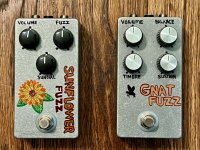jeffwhitfield
Well-known member
Got a bundle of a few GE trannies and wanted to try them out. So, I got the Sunflower and Gnat boards to experiment with. I ordered a set of MP20A's and a set of GT402B's. I had used some MP20A's on a few previous projects and liked them. However, they tend to be on the lower HFe side so I got the GT402B's to compensate. For a typical Fuzz Face type circuit, I figure the MP20A's can handle the 60-80 range with the GT402B's for the 120-ish range. After trying them out in these circuits, I think I was pretty much on mark. They definitely sound pretty darn good! 






